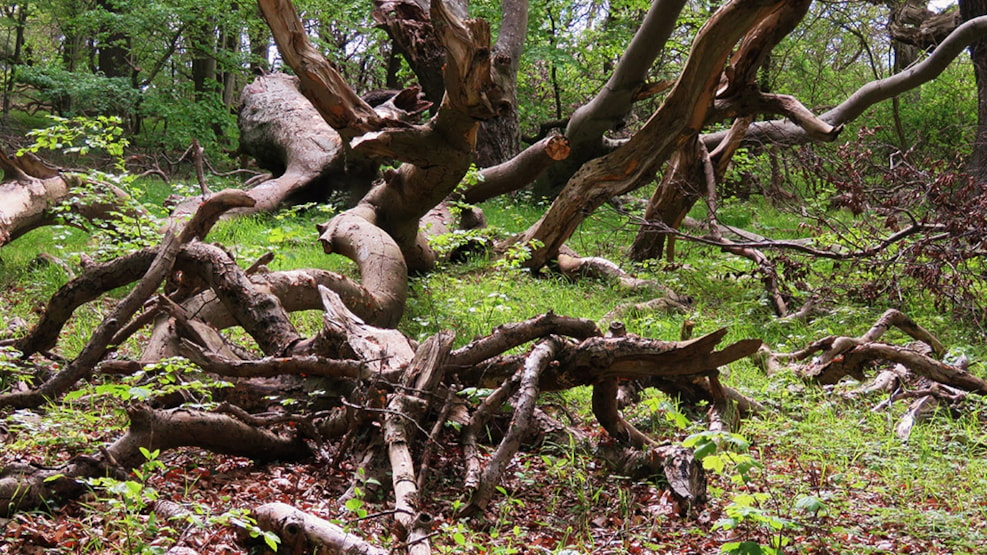
Skovene på Nordlangeland
A large forested area around the port of Lohals on the northernmost part of Langeland.
Introduction
The forested area is state-owned and comprises five forests: Østre Stigtehave (East Stigtehave), Vestre Stigtehave (West Stigtehave), Vestervænge, Bræmlevænge, and Mørkholm Skov (Mørkholm Forest) covering a total of 3.90 km2.
Habitat description
All the forests in the area are worth visiting. They each have their own characteristics and together they form the largest forested area on Langeland. Many adventures await the observant forest guest, particularly in Vestre Stigtehave. The edge of the wood on the western side is protected and trees are not allowed to be felled or removed. Thus, you will find large old trees and trunks and lots of dead wood with great biodiversity. The area has many beech and oak trees that are much older than 100 years.
In the eastern part of Vestre Stigtehave there is a small museum of forest history called Hollænderhuset (the Hollander House). Here was one of the first small dairies that at the time was called a hollænderi. South of this historic building, a small wood garden has been created where various types of trees in the forest are represented. In the stretch from Hollænderhuset out to the coast to the west, there are ridges and furrows on the forest floor from the very early utilisation of the soil for farming. They date back to 3,000 BCE. Toward the south, the edge of the wood contains a very well preserved forest reserve wall from the beginning of the 1800s.
The starting point for the entire cultural environment and cultural history of the area is the port of Lohals. Here stands a sawmill that was being supplied with timber from the local forests. In the harbour there was lots of activity with ferries sailing to Zealand and connections to Copenhagen with many holiday visitors and transport of goods to and from Langeland. There are still many preserved properties in Lohals from that time, including notable buildings that were beach hotels in the early 1900s.
Directly south and north of Lohals, you will find two well preserved and historically interesting manors, Charlottenlund on the north side and Stensgaard on the south side with their forests and farmland.
Black squirrel
In 2012, 27 black squirrels (Sciurus vulgaris) were released into the forests around Lohals in order to protect this particular type of squirrel. The black squirrel is a type of squirrel that immigrated from Southern Europe after the Ice Ages, whereas the red, genetically dominant squirrel was imported much later. In 2020, the animal population in the forests around Lohals is estimated to be 60–70.
The release of the black squirrel was done through a collaboration between the Danish Society for Nature Conservation, Natural History Museum of Denmark, National Environmental Research Institute of Denmark, and the Danish Nature Agency Funen.
Squirrels contribute to the increase of biodiversity in the forests. They are a so-called key species that by its presence has a positive influence on many other species.
Value
The entire area has high value in that it is an area of relatively high protection status in terms of both its landscape and biology. From a nature perspective, it has a relatively high degree of biodiversity in parts of the forest area as well as along the coast, where biotopes appear in many places in the breaking zone. From a culture-historical perspective, it is based on the relatively few changes in utilisation of the land over the last century.
Protection and legislation
Within the above-mentioned forests, there are several types of protected nature (Nature Conservation Act Sect. 3) such as marshes, ponds, salt meadows, pastures, etc., and there is beach protection (Nature Conservation Act Sect. 15) for the outermost 300 m of the western part of Vester Prisskov and Vester Stigtehave.
Together with Bræmlevænge and Mørkholm forests, Østre and Vestre Stigtehave were designated and internationally protected by Natura 2000 255, Habitatområde H264 in 2019. The designation is important because of the presence of western barbastella (Barbastella barbastellus) and the old types of forest.
Public access
The general public has access to the entire area along roads and paths and along the coast. There are number of parking facilities as well as a brochure that describes the paths through the forest. Shelters have been established for primitive overnight stays in many places.